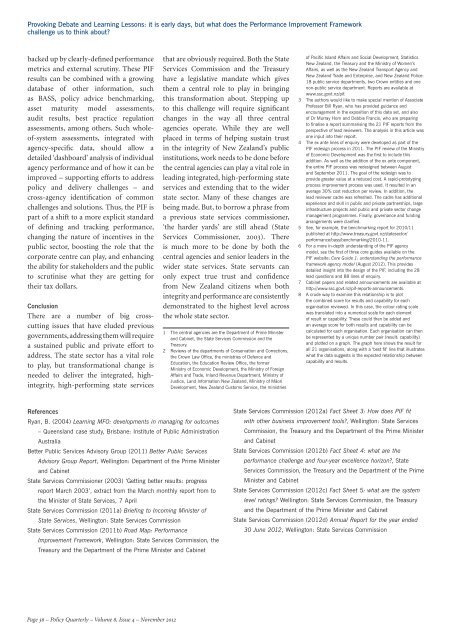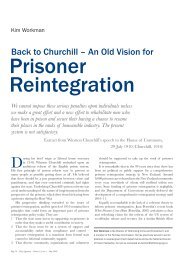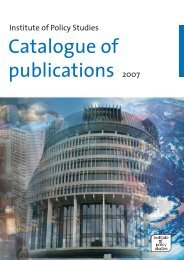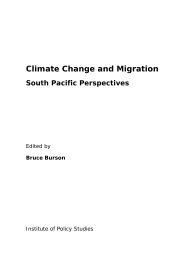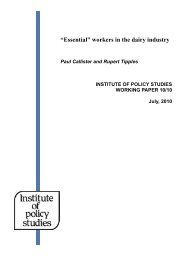PDF File - Institute for Governance and Policy Studies - Victoria ...
PDF File - Institute for Governance and Policy Studies - Victoria ...
PDF File - Institute for Governance and Policy Studies - Victoria ...
Create successful ePaper yourself
Turn your PDF publications into a flip-book with our unique Google optimized e-Paper software.
Provoking Debate <strong>and</strong> Learning Lessons: it is early days, but what does the Per<strong>for</strong>mance Improvement Framework<br />
challenge us to think about<br />
backed up by clearly-defined per<strong>for</strong>mance<br />
metrics <strong>and</strong> external scrutiny. These PIF<br />
results can be combined with a growing<br />
database of other in<strong>for</strong>mation, such<br />
as BASS, policy advice benchmarking,<br />
asset maturity model assessments,<br />
audit results, best practice regulation<br />
assessments, among others. Such wholeof-system<br />
assessments, integrated with<br />
agency-specific data, should allow a<br />
detailed ‘dashboard’ analysis of individual<br />
agency per<strong>for</strong>mance <strong>and</strong> of how it can be<br />
improved – supporting ef<strong>for</strong>ts to address<br />
policy <strong>and</strong> delivery challenges – <strong>and</strong><br />
cross-agency identification of common<br />
challenges <strong>and</strong> solutions. Thus, the PIF is<br />
part of a shift to a more explicit st<strong>and</strong>ard<br />
of defining <strong>and</strong> tracking per<strong>for</strong>mance,<br />
changing the nature of incentives in the<br />
public sector, boosting the role that the<br />
corporate centre can play, <strong>and</strong> enhancing<br />
the ability <strong>for</strong> stakeholders <strong>and</strong> the public<br />
to scrutinise what they are getting <strong>for</strong><br />
their tax dollars.<br />
Conclusion<br />
There are a number of big crosscutting<br />
issues that have eluded previous<br />
governments, addressing them will require<br />
a sustained public <strong>and</strong> private ef<strong>for</strong>t to<br />
address. The state sector has a vital role<br />
to play, but trans<strong>for</strong>mational change is<br />
needed to deliver the integrated, highintegrity,<br />
high-per<strong>for</strong>ming state services<br />
that are obviously required. Both the State<br />
Services Commission <strong>and</strong> the Treasury<br />
have a legislative m<strong>and</strong>ate which gives<br />
them a central role to play in bringing<br />
this trans<strong>for</strong>mation about. Stepping up<br />
to this challenge will require significant<br />
changes in the way all three central<br />
agencies operate. While they are well<br />
placed in terms of helping sustain trust<br />
in the integrity of New Zeal<strong>and</strong>’s public<br />
institutions, work needs to be done be<strong>for</strong>e<br />
the central agencies can play a vital role in<br />
leading integrated, high-per<strong>for</strong>ming state<br />
services <strong>and</strong> extending that to the wider<br />
state sector. Many of these changes are<br />
being made. But, to borrow a phrase from<br />
a previous state services commissioner,<br />
‘the harder yards’ are still ahead (State<br />
Services Commissioner, 2003). There<br />
is much more to be done by both the<br />
central agencies <strong>and</strong> senior leaders in the<br />
wider state services. State servants can<br />
only expect true trust <strong>and</strong> confidence<br />
from New Zeal<strong>and</strong> citizens when both<br />
integrity <strong>and</strong> per<strong>for</strong>mance are consistently<br />
demonstrated to the highest level across<br />
the whole state sector.<br />
1 The central agencies are the Department of Prime Minister<br />
<strong>and</strong> Cabinet, the State Services Commission <strong>and</strong> the<br />
Treasury.<br />
2 Reviews of the departments of Conservation <strong>and</strong> Corrections,<br />
the Crown Law Office, the ministries of Defence <strong>and</strong><br />
Education, the Education Review Office, the <strong>for</strong>mer<br />
Ministry of Economic Development, the Ministry of Foreign<br />
Affairs <strong>and</strong> Trade, Inl<strong>and</strong> Revenue Department, Ministry of<br />
Justice, L<strong>and</strong> In<strong>for</strong>mation New Zeal<strong>and</strong>, Ministry of Mäori<br />
Development, New Zeal<strong>and</strong> Customs Service, the ministries<br />
of Pacific Isl<strong>and</strong> Affairs <strong>and</strong> Social Development, Statistics<br />
New Zeal<strong>and</strong>, the Treasury <strong>and</strong> the Ministry of Women’s<br />
Affairs, as well as the New Zeal<strong>and</strong> Transport Agency <strong>and</strong><br />
New Zeal<strong>and</strong> Trade <strong>and</strong> Enterprise, <strong>and</strong> New Zeal<strong>and</strong> Police:<br />
18 public service departments, two Crown entities <strong>and</strong> one<br />
non-public service department. Reports are available at<br />
www.ssc.govt.nz/pif.<br />
3 The authors would like to make special mention of Associate<br />
Professor Bill Ryan, who has provided guidance <strong>and</strong><br />
encouragement in the exposition of this data set, <strong>and</strong> also<br />
of Dr Murray Horn <strong>and</strong> Debbie Francis, who are preparing<br />
to finalise a report summarising the 21 PIF reports from the<br />
perspective of lead reviewers. The analysis in this article was<br />
one input into their report.<br />
4 The ex ante lines of enquiry were developed as part of the<br />
PIF redesign process in 2011. The PIF review of the Ministry<br />
of Economic Development was the first to include this<br />
addition. As well as the addition of the ex ante component,<br />
the entire PIF process was redesigned between August<br />
<strong>and</strong> September 2011. The goal of the redesign was to<br />
provide greater value at a reduced cost. A rapid-prototyping<br />
process improvement process was used. It resulted in an<br />
average 30% cost reduction per review. In addition, the<br />
lead reviewer cadre was refreshed. The cadre has additional<br />
experience <strong>and</strong> skill in public <strong>and</strong> private partnerships, large<br />
infrastructure projects <strong>and</strong> public <strong>and</strong> private sector change<br />
management programmes. Finally, governance <strong>and</strong> funding<br />
arrangements were clarified.<br />
5 See, <strong>for</strong> example, the benchmarking report <strong>for</strong> 2010/11<br />
published at http://www.treasury.govt.nz/statesector/<br />
per<strong>for</strong>mance/bass/benchmarking/2010-11.<br />
6 For a more in-depth underst<strong>and</strong>ing of the PIF agency<br />
model, see the first of three core guides available on the<br />
PIF website: Core Guide 1: underst<strong>and</strong>ing the per<strong>for</strong>mance<br />
framework agency model (August 2012). This provides<br />
detailed insight into the design of the PIF, including the 28<br />
lead questions <strong>and</strong> 88 lines of enquiry.<br />
7 Cabinet papers <strong>and</strong> related announcements are available at<br />
http://www.ssc.govt.nz/pif-reports-announcements.<br />
8 A crude way to examine this relationship is to plot<br />
the combined score <strong>for</strong> results <strong>and</strong> capability <strong>for</strong> each<br />
organisation reviewed. In this case, the colour rating scale<br />
was translated into a numerical scale <strong>for</strong> each element<br />
of result or capability. These could then be added <strong>and</strong><br />
an average score <strong>for</strong> both results <strong>and</strong> capability can be<br />
calculated <strong>for</strong> each organisation. Each organisation can then<br />
be represented by a unique number pair (result: capability)<br />
<strong>and</strong> plotted on a graph. The graph here shows the result <strong>for</strong><br />
all 21 organisations, along with a ‘best fit’ line that illustrates<br />
what the data suggests is the expected relationship between<br />
capability <strong>and</strong> results.<br />
References<br />
Ryan, B. (2004) Learning MFO: developments in managing <strong>for</strong> outcomes<br />
– Queensl<strong>and</strong> case study, Brisbane: <strong>Institute</strong> of Public Administration<br />
Australia<br />
Better Public Services Advisory Group (2011) Better Public Services<br />
Advisory Group Report, Wellington: Department of the Prime Minister<br />
<strong>and</strong> Cabinet<br />
State Services Commissioner (2003) ‘Getting better results: progress<br />
report March 2003’, extract from the March monthly report from to<br />
the Minister of State Services, 7 April<br />
State Services Commission (2011a) Briefing to Incoming Minister of<br />
State Services, Wellington: State Services Commission<br />
State Services Commission (2011b) Road Map: Per<strong>for</strong>mance<br />
Improvement Framework, Wellington: State Services Commission, the<br />
Treasury <strong>and</strong> the Department of the Prime Minister <strong>and</strong> Cabinet<br />
State Services Commission (2012a) Fact Sheet 3: How does PIF fit<br />
with other business improvement tools, Wellington: State Services<br />
Commission, the Treasury <strong>and</strong> the Department of the Prime Minister<br />
<strong>and</strong> Cabinet<br />
State Services Commission (2012b) Fact Sheet 4: what are the<br />
per<strong>for</strong>mance challenge <strong>and</strong> four-year excellence horizon, State<br />
Services Commission, the Treasury <strong>and</strong> the Department of the Prime<br />
Minister <strong>and</strong> Cabinet<br />
State Services Commission (2012c) Fact Sheet 5: what are the system<br />
level ratings Wellington: State Services Commission, the Treasury<br />
<strong>and</strong> the Department of the Prime Minister <strong>and</strong> Cabinet<br />
State Services Commission (2012d) Annual Report <strong>for</strong> the year ended<br />
30 June 2012, Wellington: State Services Commission<br />
Page 36 – <strong>Policy</strong> Quarterly – Volume 8, Issue 4 – November 2012


